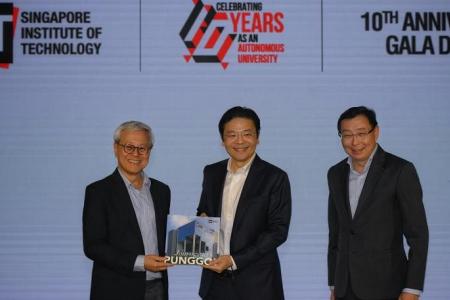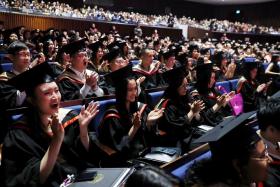Punggol Coast MRT station to be extension of new SIT campus
The upcoming Punggol Coast MRT station will be developed as an extension of the new Singapore Institute of Technology (SIT) campus, providing students and the public with a space for community engagement, research and learning.
Situated within JTC Corporation’s Punggol Digital District, the campus will have the Punggol Coast station right at its doorstep, SIT president Chua Kee Chaing said on March 20.
He was speaking at SIT’s 10th anniversary gala, with more than 350 guests, including Deputy Prime Minister Lawrence Wong, Minister for Education Chan Chun Sing, Minister for Defence Ng Eng Hen and Minister for Health Ong Ye Kung.
The new campus will welcome its first students in September 2024, and the Punggol Coast station will be operational at the end of 2024.
The extension of the SIT campus is a tie-up between the university and SBS Transit to drive innovation and research in the public transport sector, with an agreement signed on March 20.
Professor Chua said this new space will provide students with the opportunity to apply what they have learnt to real-world challenges, taking advantage of the location that the new campus is in, to collaborate with industry partners.
Key features of the campus extension include a multi-purpose space that can be used by both SIT students and the public for events like performances, exhibitions and community functions.
New digital platforms will also be developed to encourage innovation, one of which is a digital sandbox – a 3D replica of the physical MRT station, which allows students and faculty to engage in more hands-on learning experiences, tackle problems and explore solutions in a safe and inexpensive way.
Another platform will feature projects such as trialling the use of generative artificial intelligence technology to power a digital concierge at SBS Transit’s bus interchanges and MRT stations.
Prof Chua said the university will expand its outreach in Punggol by working with secondary schools in the area, as well as providing workshops and talks for the public, as part of efforts to build strong connections with the surrounding community.
Established as Singapore’s fifth autonomous university in 2014, SIT focuses on applied learning and research through its range of industry-relevant programmes, and has since grown to offer 39 undergraduate degree programmes.
Its intake has grown from 1,800 students in 2014 to 3,300 now, with an over 90 per cent employment rate. It has an 18,000-strong alumni community.
DPM Wong, who gave the opening address at the dinner, said SIT was best placed to lead Singapore’s applied degree pathway, an idea conceived in 2012 by then Education Minister Heng Swee Keat and the Committee on University Education Pathways Beyond 2015.
“The committee assessed that there was scope to increase the university cohort participation rates for young Singaporeans, and open up more degree places, but we wanted to explore a different pathway that would better suit the diverse abilities and inclinations of our youth,” DPM Wong said, adding that this route would allow individuals who preferred hands-on learning to obtain university degrees.
He said 2024 will be an exciting year for SIT as it moves to its new campus in Punggol.
“This will not just be a new physical home. There will be more opportunities to collaborate with the industry on the latest in digital technologies such as cyber security, because of proximity to the Punggol Digital District. Companies can also use your campus as a test bed for smart urban solutions.”
Get The New Paper on your phone with the free TNP app. Download from the Apple App Store or Google Play Store now


